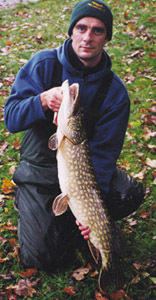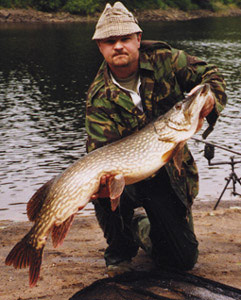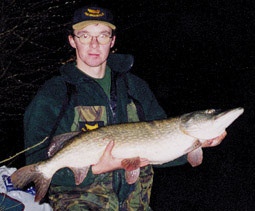 |
 |
 |
| HOME | CONTENTS | JOIN HERE | |||||
| ABOUT
PAC | |||||||
|
Whenever you are in conversation with other like-minded lads and lassies and someone mentions the word 'livebaits', why is it that 9 out of 10 automatically think of a gudgeon or small roach under some sort of bung, gently bobbing in ever decreasing circles? This is usually the picture painted not only by pike anglers, but anyone that wets a line. Now please forgive me for being gobby (no comments about Wiganers please), but these ideas seem to have come from our distant and illustrious (well sometimes not so illustrious) past. Why should this be so, because we still employ basically the same tactics today, namely the free-roamer method and contrary to popular belief the only difference in today's set-up is the float. It was the gazette bung, now it's a livebait slider. The two trebles and 18 inch wire trace complete with swivel, have been standard issue so to speak since Alfred Jardine invented the snap- tackle, and weights are weights which- ever way you care to look at them. The only way this method differs from say 20 years ago is in striking into the fish. Let me explain if I may. History dictates the belief that the pike grabbed the bait crossways across the jaws, then ran to their lair to turn and swallow his meal head first. Hence, when a run occurred, the angler would pour himself a brew, have a cig, another brew and only then would the rod be taken from the rests and see the angler bend into the fish (there was no need to strike). Now although this did lead to a better hooking rate, because of the obvious reasons of deep hooking, led to the death of thousands of pike. But the theory was so simple it must be true? Utter and absolute codswallop! Of course we are all more enlightened these days in pike behaviour and their feeding habits, so this should no longer be a major problem and yes, I know that deep hooked fish do come to the bank occasionally. But we are now in a more favourable position than ever our forebears where. With the developments in forceps, hook-outs and deep throat disgorgers, the pike has a much better chance of survival, should the problem occur. I honestly don't know whether to feel glad or sad for you, glad that you're leaving all those pike unmolested or sad that you cannot be bothered to get off your behind, because you could truly be missing out on some fantastic action. I can remember in the past dodging the kicks and punches from my significant other half because of a bathfull of live roach and crucians, as I had nowhere else to keep them and "yes darling, they will be gone by the time you get up tomorrow". Then comes the predictable reply of 'oh yes, and so will you with your suitcases if they're not!" This went on most weekends until I built a purpose made 8x4 tank in the back garden. So that problem was solved, for the time being anyway, as the pump farted and faltered, that universal tool we all love, the hammer, sorted the problem. These days you will find me on the bank with a bucket and waggler rod in hand, as a lot of fisheries don't allow wrigglers to be brought on site. A fair comment, because of the obvious risk of disease etc. However, if you ask nicely enough and go cap in hand, they might allow you to bring health certified live trout, but I stress ASK first, as there is probably no better way to be banned from a water than to be caught using lives which have obviously not come from the said water in which you are fishing. We have enough problems as it is without giving the powers that be, ammunition to fire at us, and believe me these lads do not fire blanks, it is only a quid for half a pint of maggots, so get bit bashing. You have been warned! A pike's feeding habits vary greatly from one water to another, up and down the country. Some waters are notoriously good deadbait waters and vice-versa. When lives outscore deads and the pike show a definite preference for one type of bait, this can be broken down still further by the use of seabaits or coarse naturals. The anglers baitbox should be packed accordingly, as the pike can and does become pre-occupied with feeding on one type of bait. In saying this, there can be very few waters where a livebait will not be taken. The sight of a struggling fish be it with or without the addition of trebles, will almost certainly draw the attention of any passing predator whether they are feeding or not. The fish's struggles hold the trigger for any pike to instantly turn onto hunting mode, even if they are not hungry. Pike can be observed stalking a struggling fish, sometimes to within inches of it's snout. It is this type of response that we as the angler try to aim for. Now there is not the slightest chance of this response occurring with a static deadbait, lying immobile on the lake bed.
There are no hard and fast rules to govern a pikes feeding habits, in some situations they can change from month to month, with different weather conditions, high and low air pressures, clear or coloured water etc. The circumstances could be endless. After a hard day with little or nothing to show for your efforts, while on other days runs can come steadily throughout the session or maybe 3 or 4 runs condensed into a couple of short feeding spells. It is then a feeling of content, knowing that you are finally getting to grips with this fishing crack. Only for it to all change in a few short weeks or even days, sending you back to square one trying to find the right bait, water conditions etc, which is why I suppose we keep chopping and changing. If it was easy all the time, I don't think we would stick it?? Livebaits can give you an edge on many more waters than people would have you believe. If it is constant success that you are after, then it is advisable to learn different methods, (including lure fishing) because presentations and approaches are unlike each other. If we could learn to tell what the pike prefer on any particular day prior to going to the bank, life would be much more simple, of course it is not, so once more into the breach, treading that notoriously difficult path to become that person we all wish we could be, the complete pike angler. This
article first appeared in Pikelines 94 (November 2001) - on this website 28/12/02 |
 Have
you ever sat down and tried to fathom out how predator angler's minds work? No,
I am not talking about Pamela Anderson or Guinness, I am talking about pike fishing,
so you can stop all that nonsense right away... Thank you very much!
Have
you ever sat down and tried to fathom out how predator angler's minds work? No,
I am not talking about Pamela Anderson or Guinness, I am talking about pike fishing,
so you can stop all that nonsense right away... Thank you very much! Harking
back to the beginning of this article, namely the use of livebaits, not wanting
to get into the politics and morals of the method as I have done elsewhere. Was
it really worth the effort? I mean think about it, the hassle of first catching
you baits, then trying to keep them alive long enough to take them with you to
the bank, then there's the worry of constantly casting them off the hooks and
hoping that they are still alive and doing the business. Not to mention what was
a long slog from the car to your chosen peg, with a bucketfull of water banging
against your leg, and your normal tackle to hump as well. Christ, the para's didn't
go through this on their way to Goose Green! No, sod that for a lark, I have some
mackerel and smelt in the bottom of the freezer, that will do for me.
Harking
back to the beginning of this article, namely the use of livebaits, not wanting
to get into the politics and morals of the method as I have done elsewhere. Was
it really worth the effort? I mean think about it, the hassle of first catching
you baits, then trying to keep them alive long enough to take them with you to
the bank, then there's the worry of constantly casting them off the hooks and
hoping that they are still alive and doing the business. Not to mention what was
a long slog from the car to your chosen peg, with a bucketfull of water banging
against your leg, and your normal tackle to hump as well. Christ, the para's didn't
go through this on their way to Goose Green! No, sod that for a lark, I have some
mackerel and smelt in the bottom of the freezer, that will do for me. Trying
to impart a bit of life into your deadbait by wobbling or twitching the bait a
few feet every now and then goes some way to alleviating the problem of a static
bait. However, it is by no way a substitute for a live wriggler and I won't mention
lures because my feelings are well known on the this (ask Gordy). Ten hours at
Llandegfedd flinging bits of wood and plastic, with spotties the only takers had
me running home to the livebait rods. Kissing and cuddling them to such a degree
that funny looks were coming my way from the wife and kids.
Trying
to impart a bit of life into your deadbait by wobbling or twitching the bait a
few feet every now and then goes some way to alleviating the problem of a static
bait. However, it is by no way a substitute for a live wriggler and I won't mention
lures because my feelings are well known on the this (ask Gordy). Ten hours at
Llandegfedd flinging bits of wood and plastic, with spotties the only takers had
me running home to the livebait rods. Kissing and cuddling them to such a degree
that funny looks were coming my way from the wife and kids.